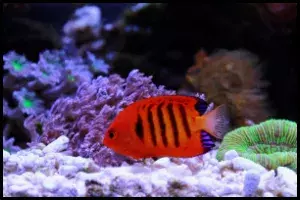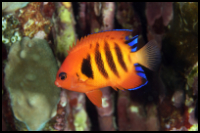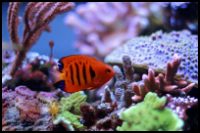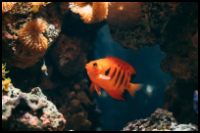





Quick Care Details (Table)
| Livestock Characteristics | Value |
|---|---|
| Care Level | Moderate |
| Temperament | Semi-Aggressive |
| Diet | Omnivore |
| Maximum Size | 4 Inches |
| Minimum Tank Size | 30 Gallons |
| Reef Compatible | With Caution |
| Temperature Range | 72-78F |
| PH Range | 8.1-8.4 |
| DKH Range | 8-12 |
| Salinity Range | 1.020-1.025 |
Species Specific Categories
Helpful Video
Care Details
Aquascape: Visualize your aquarium as a miniature coral wonderland. To make Flame Angelfish feel right at home, craft your tank into a coral reef masterpiece. Arrange live rocks with hidden nooks and crannies for their curious explorations, and leave some open water for graceful swimming.
Substrate: For the aquarium floor, consider a luxurious bed of fine coral sand or aragonite. It's not only aesthetically pleasing but also allows Flame Angelfish to indulge in their natural behavior of sifting through the sand for tiny treasures.
Disease Prevention: Keep your finned friends in tip-top shape by implementing a little quarantine protocol for newcomers before they join the main tank party. Flame Angelfish, like many marine species, are vulnerable to common underwater ailments. So, maintaining pristine water quality, a balanced diet, and regular tank TLC is the golden ticket to their well-being.
Filtration: Picture your filtration system as the unsung hero of your aquatic universe. A reliable protein skimmer and a trusty canister or sump filter work tirelessly behind the scenes to maintain water quality, removing waste, and keeping those water parameters steady.
Lighting: Flame Angelfish fancy their fair share of lighting drama. They thrive under moderate to high-intensity illumination, which not only complements their algae-grazing habits but also nourishes the delicate corals sharing their space.
Water Flow: Imagine a gentle underwater breeze. Flame Angelfish prefer spots with a mild current, so provide them with this gentle flow to create a comfortable environment and ensure a constant supply of oxygen.
Hardiness: These fish are the rugged individuals of the aquarium world. They adapt quite well to diverse tank conditions, making them a solid choice for those who've got some aquatic experience under their belt.
Acclimation: When introducing new Flame Angelfish to their new abode, be the gracious host. Slowly add a bit of your tank's water to their bag over the course of an hour or so, allowing them to acclimate at their own pace.
Expected Lifespan: With tender love and care, you can expect your Flame Angelfish to grace your underwater world for approximately 5 to 7 years, possibly even more. A nutritious diet and proper care play pivotal roles in ensuring their long and happy lives.
Special Requirements: Flame Angelfish are like culinary connoisseurs of the sea, so serve up a delectable variety of high-quality flake foods, tantalizing frozen delicacies, and live or freeze-dried treats. An occasional platter of marine algae or seaweed will be the icing on the aquatic cake.
Temperament and Behavior
Behavior and Social Interaction: Flame Angelfish have quite the personality. They're often seen darting around, exploring their environment. They're not typically shy and tend to be active during the day. However, they aren't known to be the most social fish and often prefer to go solo or live with a compatible mate.
Aggression: Despite their stunning appearance, Flame Angelfish can be a bit feisty. They have a territorial streak and can be aggressive, especially towards fish with a similar body shape or those invading their space. So, be careful when selecting tankmates.
Breeding: Breeding Flame Angelfish in captivity can be a bit of a challenge. They lay eggs, but successfully raising the fry (young fish) can be demanding and requires specific conditions and care.
Compatibility with Inverts and Fish: Flame Angelfish have a taste for soft and stony corals and may pick at small invertebrates like tube worms and small anemones. However, their appetites for these critters can vary from one fish to another. It's crucial to be cautious when choosing tankmates. Avoid housing them with other angelfish, particularly of the same or similar species. Opt for tankmates that won't trigger their territorial instincts.
Activity Level: These fish are active swimmers and enjoy exploring their surroundings. You'll often catch them darting around the tank, especially when they're hungry or on the lookout for a new hiding spot.
Clean-Up Crew: Flame Angelfish will definitely eat algae, but for more efficient algae control, it's better to rely on other species like tangs and blennies.
Schooling or Shoaling Behavior: Flame Angelfish don't display schooling or shoaling behavior like some other fish. They're usually solitary, or you might find them in pairs when they're breeding.
Coral Reef Compatibility: In the wild, Flame Angelfish are at home in coral reefs. However, in a reef tank, it's a bit of a love-hate relationship. They may nip at soft and large stoney polop coral, so if you have a reef tank, be choosy about the corals you select and keep a close eye on their behavior.
Diet and Nutrition
Dry Foods: Think of dry foods as the everyday basics in your Flame Angelfish's diet. These are like their daily bread, in the form of high-quality flake foods specially designed for marine angelfish. They're easy to manage and provide all the essential nutrients your fish need.
Frozen Foods: Frozen foods are like gourmet treats for your Flame Angelfish. They add a bit of excitement to mealtime. You can serve up a variety of frozen delights, like brine shrimp, mysis shrimp, and other marine goodies, to keep their taste buds tingling.
Live Foods: Live foods add a bit of adventure to their diet. These little critters, such as brine shrimp and daphnia, give your angelfish a chance to channel their inner hunter. The chase makes mealtime more engaging for them.
Vegetables: Even fish need their veggies! Marine angelfish have a particular fondness for marine algae and seaweed. You can attach small pieces of these greens to the tank, giving your angelfish a chance to graze and helping control algae growth in your aquarium.
Algae: Imagine algae as the salad bar in your fish's diet. Flame Angelfish are natural grazers and enjoy nibbling on microalgae that grows in your tank. However, it's a good practice to offer a variety of foods to make sure they're getting all the nutrients they need.
Feeding Schedule: Maintaining a regular feeding schedule is key. Aim for 2-3 small meals a day to keep your Flame Angelfish well-fed. Be cautious not to overfeed, as uneaten food can harm water quality. Pay attention to their eating habits and adjust portion sizes as needed.
Supplemental Foods: Consider adding some supplements to their diet. Vitamin-enriched foods or specially formulated pellets for marine angelfish can provide an extra nutritional boost. These supplements ensure your angelfish get all the vital vitamins and minerals for a healthy life.
Tank Parameters
Tank Size: Imagine your tank as a comfortable home for your Flame Angelfish. A tank size of at least 55 gallons is recommended for a single Flame Angelfish. Larger tanks are even better if you plan to keep a pair or multiple tank mates.
Tank Length and Measurements: For a 55-gallon tank, dimensions of 48 inches in length, 13 inches in width, and 20 inches in height are often suitable. However, always aim for a tank with ample horizontal swimming space as these fish are active swimmers.
Species Maximum Size: Flame Angelfish can grow to around 4 inches (10 centimeters) in length, so they are considered a smaller species among marine angelfish.
Water Temperature: Maintain the water temperature in the range of 72-78°F (22-26°C). This temperature range mimics their natural habitat and keeps them comfortable.
pH (Acidity/Alkalinity): The ideal pH level for Flame Angelfish is around 8.1 to 8.4. It's important to keep the pH stable within this range to ensure their well-being.
Nitrate (NO3) Levels: Nitrate levels should be kept low, ideally below 10-20 parts per million (ppm). Regular water changes and good filtration will help maintain healthy nitrate levels.
Salinity: Flame Angelfish thrive in a marine environment with a specific gravity of about 1.023-1.025. This corresponds to salinity levels that are slightly higher than freshwater. A quality hydrometer or refractometer will help you monitor and adjust the salinity as needed.
Phosphate (PO4): Keep phosphate levels low in the range of 0.03-0.08 ppm to prevent excess algae growth. Good water quality and efficient filtration are key to maintaining appropriate phosphate levels.
Alkalinity (dKH): Alkalinity, often measured in degrees of carbonate hardness (dKH), should be maintained between 8-12 dKH. This range helps stabilize pH and ensures the overall stability of the aquarium environment.
History, Popularity, History and Species Variety Details
The History, Popularity and Natural Habitat
History: Flame Angelfish, scientifically known as Centropyge loricula, have quite a history in the marine aquarium world. They've been captivating aquarists for a while now. The story of these beautiful fish dates back to the 19th century when French biologist Achille Valenciennes first described them. Since then, they've become quite a sought-after species in the aquarium hobby, thanks to their stunning appearance and lively behavior.
Popularity: The Flame Angelfish is a bit of a superstar in the marine aquarium scene. Their vibrant red or orange bodies, adorned with bold black stripes, make them a real showstopper. Their striking looks and intriguing personalities have made them a centerpiece in many reef tanks. However, it's worth noting that their popularity comes with some challenges, as they can be a bit finicky to care for due to their specific dietary and environmental needs.
Natural Habitat: In the wild, Flame Angelfish enjoy the warm waters of the Indo-Pacific. You can spot them in regions around the Hawaiian Islands, the Great Barrier Reef in Australia, and various other spots in the Central and Western Pacific Ocean. They're particularly fond of living in coral reefs and lagoons, where they seek shelter among the nooks and crannies of the coral formations. Their striking colors serve them well, helping them blend in and find refuge in their natural habitat.
Flame Angelfish have adapted to the vibrant and complex ecosystem of coral reefs, where they graze on algae and small invertebrates. This natural diet plays a significant role in their health and behavior, making it crucial to mimic their dietary preferences when caring for them in your home aquarium.
In a nutshell, Flame Angelfish have an interesting history and are quite the stars in the marine aquarium world. Their natural habitat in the Indo-Pacific is a colorful and diverse coral reef environment, where their captivating appearance and behavior truly shine. Understanding their origins and natural preferences is key to giving them the best care in your own aquarium.
Similar Dwarf Angelfish
- Flame Angelfish (Centropyge loricula): These are popular for their vibrant red-orange bodies and bold black stripes.
- Coral Beauty Angelfish (Centropyge bispinosa): Known for their stunning orange and blue coloration, they're great additions to reef tanks.
- Lemonpeel Angelfish (Centropyge flavissima): These small, attractive fish sport a bright yellow hue and are ideal for reef setups.
- Potter's Angelfish (Centropyge potteri): Featuring a mix of yellow, orange, and blue colors, they're a favorite among marine enthusiasts.
- Flameback Angelfish (Centropyge acanthops): These angelfish boast a fiery red-orange color with a distinctive yellow blaze near the caudal fin.
- Multibar Angelfish (Paracentropyge multifasciata): Characterized by alternating dark and light bars, giving them a unique appearance.
- Pearlscale Angelfish (Centropyge vrolikii): Their textured or "pearlscale" appearance sets them apart in any aquarium.
- Fisher's Angelfish (Centropyge fisheri): Known for the striking blue and yellow contrast and a "mask" over their eyes.
- Eibli Angelfish (Centropyge eibli): Recognizable by their light yellow or white color with subtle blue accents.
- Rusty Angelfish (Centropyge ferrugata): Typically brown with subtle orange highlights, they offer a more subdued appearance compared to other dwarf angelfish.
Variations of the flame angelfish
- Hawaiian Flame Angelfish (Centropyge loricula): These are typically found in the Hawaiian Islands. They often have more vibrant and intense coloration, with a fiery red body and bold black stripes.
- Fiji Flame Angelfish: Flame Angelfish from the Fiji region might exhibit variations in color. They can sometimes be slightly more subdued in their coloration, with a deeper red or orange hue.
- Christmas Island Flame Angelfish: Flame Angelfish from Christmas Island, a remote coral atoll in the Indian Ocean, are known for their unique coloration. They often have more intense orange coloring, and their black stripes can sometimes appear thicker.
- Hybrid Variations: In captivity, breeders sometimes produce hybrid variations by crossing Flame Angelfish with other angelfish species. These hybrids can exhibit different color patterns and combinations, which can be quite striking.
Frequently Asked Questions
What size tank do they need?
A 55-gallon tank is sufficient for a single Flame Angelfish. Larger tanks are better if you plan to have more fish.
Are Flame Angelfish reef-safe?
They can be reef-safe but may nibble on soft and stony corals. Choose tank mates wisely.
What's their diet like?
Flame Angelfish are omnivores. Offer a mix of dry, frozen, live, and vegetable-based foods. They love grazing on algae too.
Do they get along with other fish?
They can be territorial and even aggressive. Select tank mates carefully, avoiding fish with similar body shapes.
What's their natural habitat like?
Flame Angelfish are found in the Indo-Pacific, dwelling in coral reefs and lagoons where they seek shelter among corals.
How long do they live?
With proper care, Flame Angelfish can live up to 5-7 years or more.
What's their temperament like?
They have a bit of an attitude and can be territorial. Keep an eye on their interactions with tank mates.
Any tips for acclimating them?
Take it slow when introducing new fish. Gradually add your tank's water to their bag over an hour or so.
Are Flame Angelfish easy to care for?
They are considered moderately challenging due to their specific dietary needs and occasional aggression.
Can Flame Angelfish be bred in captivity?
Breeding Flame Angelfish in captivity can be challenging due to their complex reproductive behavior.

